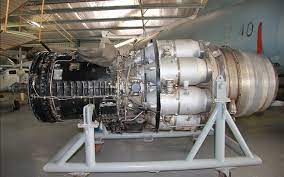Rolls Royce Avon
 Click on image for larger version
Click on image for larger version The Rolls Royce Avon was the first axial flow gas turbine engine designed and built by Rolls Royce Limited, and went on to become one of their most successful post WW2 engine designs, and powered many military and civilian aircraft.
The engine originated as a private project to power the English Electric Canberra bomber, and the original prototype was designated AJ.65 (Axial Jet 6500lb thrust) and was based on a combined axial compressor system with a combustion system, and a single stage power turbine.
Engine design began in 1945 and the first engine run was on March 25, 1947. It proved difficult to start and would not accelerate. Redesign of the inlet guide vanes and compressor bleed systems and other modifications resulted in pre production engines designated RA 2, completing a test regime and later flying in the two outboard engine nacelles of an Avro Lancastrian aircraft on August 15, 1948.
Development resulted in the original 6,500lbs thrust rating of AJ 65 and later the RA 3 that initially powered the Australian Canberra bomber followed later by the RA 7 rated at 7,500lbs thrust, as was the RA 26 that powered the Australian CA-27 Sabre, and to the ultimate rating of 12,690lbs, produced by the RA 29 that powered the English Electric Lightning.
A Canberra bomber with two Avon engines made the first non stop un-refueled trans Atlantic flight of a turbine powered aircraft, and a Comet 4 with four Avon engines made the first scheduled airline trans Atlantic flight by a turbine powered aircraft.
Avon aircraft engine production ran from 1950 until 1974, producing 11,000 plus units built by Rolls Royce and licensees that included the Government Aircraft Factory(GAF) that produced the RA 3 and later the RA 7 that powered the Australian produced Canberra bomber, and Commonwealth Aircraft Corporation (CAC), that produced the RA 26 engine that powered the CA-27 Sabre aircraft for the RAAF.
An example of the CAC built Rolls Royce RA 26 engine is on display at the Museum.
|
TECHNICAL DATA Avon RA-29 Type Length Diameter Dry weight Compressor Combusters Power turbine Maximum power Pressure ratio Thrust to weight ratio |
Gas turbine 126in (3,200mm) 35.7in (907mm) 2,890lbs (1,310kg) 15 stage - axial flow Combuster cans Two stage - axial flow 12,690lbs thrust (dry) - 16,360lbs with afterburner. 7.45/1 4.37/1 (dry) - 5.6/1 with afterburner |
